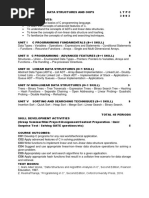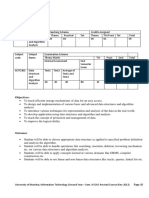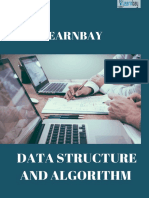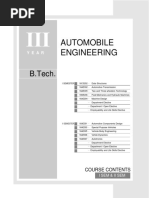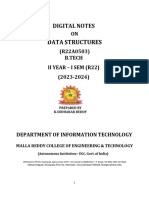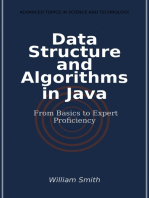BCSC 1204 - Data Structures & Algorithms - Course Outline
Uploaded by
kamaureagan24BCSC 1204 - Data Structures & Algorithms - Course Outline
Uploaded by
kamaureagan24January 2024 – April 2024 Semester
SCHOOL OF COMPUTING & INFORMATION TECHNOLOGY
COURSE OUTLINE
DEPARTMENT: COMPUTING & INFORMATION TECHNOLOGY
PROGRAMME: BACHELOR OF SCIENCE IN INFORMATION TECHNOLOGY
SEMESTER: 1
UNIT CODE: BCSC 1204 UNIT TITLE: DATA STRUCTURES & ALGORITHMS
LECTURE HOURS: 45 PRE-REQUISITES: None
LECTURER: Michael Ndege
LECTURER CONTACTS: mkinyua@cuk.ac.ke
1.0 COURSE PURPOSE
The goal of this course is to enable students:-
Develop knowledge and understanding of the underlying principles of foundational data
structures.
Build up capacity to evaluate different algorithm techniques.
Develop competence in analysing data structures.
Build up capacity to write programmes for developing simple applications.
2.0 LEARNING OUTCOMES
Upon successful completion of this course, the student should be able to:
To understand the basic concepts such as Abstract Data Types, Linear and Non-Linear Data structures.
To understand the notations used to analyze the Performance of algorithms.
To understand the behavior of data structures such as stacks, queues, trees, hash tables, search trees,
Graphs and their representations.
To choose the appropriate data structures for a specified application
To write programs in C or C++ to solve problems using data structures such as arrays, linked lists,
stacks, queues, trees, graphs, hash tables, search trees.
3.0 COURSE OUTLINE
Week Topic Sub-topic Remarks
1. Introduction to DSA - Data Types
- Data Structures
- Abstract Data Types (ADTs)
- Algorithm
- Analysis of Algorithms
- Running Time Analysis
- How to Compare Algorithms
- Rate of Growth
2. Linked Lists - Linked List
- Linked Lists ADT
- Why Linked Lists?
- Arrays Overview
January 2024 – April 2024 Semester
- Comparison (Arrays & Dynamic
Arrays)
- Singly Linked Lists
- Doubly Linked Lists
- Circular Linked Lists
3. & 4. Stacks - What is a Stack?
- How Stacks are used
- Stack ADT
- Applications
- Implementation
- Comparison of Implementations
- Stacks: Problems & Solutions
5 CAT I - CAT I
6. Queues - What is a Queue?
- How are Queues Used?
- Queue ADT
- Exceptions
- Applications
- Implementation
- Queues: Problems & Solutions
7. & 8. Trees - What is a Tree?
- Binary Trees
- Types of Binary Trees
- Properties of Binary Trees
- Binary Tree Traversals
- Generic Trees (N-ary Trees)
- Binary Tree Traversals
- Binary Search Trees (BSTs)
- Balanced Binary Search Trees
9. Priority Queues and - What is a Priority Queue?
Heaps - Priority Queue ADT
- Priority Queue Applications
- Priority Queue Implementations
- Heaps and Binary Heaps
- Binary Heaps
- Heapsort
- Priority Queues [Heaps]:
Problems & Solutions
10. CAT 2 - CAT 2
11.. Sorting - What is Sorting?
- Classification of Sorting
Algorithms
- Bubble Sort
- Selection Sort
- Insertion Sort
- Shell Sort
- Merge Sort
- Comparison of Sorting
Algorithms
- Sorting: Problems & Solutions
12 Searching - What is Searching?
January 2024 – April 2024 Semester
- Types of Searching
- Unordered Linear Search
- Sorted/Ordered Linear Search
- Binary Search
- Comparing Basic Searching
Algorithms
- Searching: Problems & Solutions
13.. Classification - Greedy Algorithms
- Divide and Conquer Algorithms
- Dynamic Programming
13 Review -
14. Exams -
4.0 TEACHING METHODOLOGY
Lectures, assignment, practical and tutorial sessions in Computer Laboratory, individual and group
assignments, exercises and project work.
5.0 INSTRUCTIONAL MATERIALS
Overhead projector and computer, handouts, white boards, Textbooks.
COURSE EVALUATION
CAT 1 = 10%
CAT 2 = 10%
OTHER ASSESSMENTS = 10%
Examination = 70%
Total = 100%
Pass mark: 40%
7.0 COURSE TEXTBOOKS
1. Data Structures using C++, Special Edition‐MRCET, Tata McGraw‐Hill Publishers 2017.
2. Data structures, Algorithms and Applications in C++, S.Sahni, University Press (India) Pvt.Ltd, 2nd
edition, Universities Press Orient Longman Pvt. Ltd.
8.0 REFERENCE TEXTBOOKS
1. Data structures and Algorithms in C++, Michael T.Goodrich, R.Tamassia and .Mount, Wiley student
edition, John Wiley and Sons.
2. Data structures and Algorithm Analysis in C++, Mark Allen Weiss, Pearson Education. Ltd., Second
Edition.
3. Data structures and algorithms in C++, 3rd Edition, Adam Drozdek, Thomson
4. Data structures using C and C++, Langsam, Augenstein and Tanenbaum, PHI.
5. Problem solving with C++, The OOP, Fourth edition, W.Savitch, Pearson education.
9.0 COURSE JOURNALS
10.0 REFERENCE JOURNALS
You might also like
- Rhetorical Analysis - Our Vanishing NightNo ratings yetRhetorical Analysis - Our Vanishing Night4 pages
- L T P C School Total Number of Contact Hours Date of Approval Pre-RequisitesNo ratings yetL T P C School Total Number of Contact Hours Date of Approval Pre-Requisites2 pages
- CD3291-Data-Structures-and-Algorithms NotesNo ratings yetCD3291-Data-Structures-and-Algorithms Notes155 pages
- Course Outline (Data Structures and Algorithms) 2021No ratings yetCourse Outline (Data Structures and Algorithms) 20217 pages
- Cse2002 Data-structures-And-Algorithms LTP 2.0 2 Cse2002 Data-structures-And-Algorithms LTP 2.0 1 Cse2002-Data Structures and AlgorithmsNo ratings yetCse2002 Data-structures-And-Algorithms LTP 2.0 2 Cse2002 Data-structures-And-Algorithms LTP 2.0 1 Cse2002-Data Structures and Algorithms3 pages
- CD3291 Data Structures and Algorithms Lecture Notes 2No ratings yetCD3291 Data Structures and Algorithms Lecture Notes 2156 pages
- cfc58dd0-c781-40c7-a228-7dac6805017d_Data_Science_Sem_7No ratings yetcfc58dd0-c781-40c7-a228-7dac6805017d_Data_Science_Sem_773 pages
- Prof. Abhiram G Ranade Prof. Ajit A Diwan Prof. Sundarviswanathan Madhavanmukund Chennai Mathematical InstituteNo ratings yetProf. Abhiram G Ranade Prof. Ajit A Diwan Prof. Sundarviswanathan Madhavanmukund Chennai Mathematical Institute2 pages
- BIS123 - Data Structures and Algorithms Course OutlineNo ratings yetBIS123 - Data Structures and Algorithms Course Outline2 pages
- Learn Data Structures and Algorithms - RoadmapNo ratings yetLearn Data Structures and Algorithms - Roadmap11 pages
- 300+ TOP DATA STRUCTURES Interview Questions and Answers PDFNo ratings yet300+ TOP DATA STRUCTURES Interview Questions and Answers PDF23 pages
- SRM Valliammai Engineering College SRM Nagar Kattankulathur Department of Computer Science and Engineering Lesson PlanNo ratings yetSRM Valliammai Engineering College SRM Nagar Kattankulathur Department of Computer Science and Engineering Lesson Plan3 pages
- Data Structures (DS) : Detailed Content Hours Introduction To Data StructureNo ratings yetData Structures (DS) : Detailed Content Hours Introduction To Data Structure4 pages
- 2CSE302: Data Structures (4 0 4 6) : Learning OutcomesNo ratings yet2CSE302: Data Structures (4 0 4 6) : Learning Outcomes2 pages
- Institute:Chandigarh Universuity Department: UicNo ratings yetInstitute:Chandigarh Universuity Department: Uic27 pages
- 3 3RD Year Automobile Syllabus (03-08-2016) 2018 08 02 11 54 43 711 PDFNo ratings yet3 3RD Year Automobile Syllabus (03-08-2016) 2018 08 02 11 54 43 711 PDF29 pages
- Data Structure and Algorithms in Java: From Basics to Expert ProficiencyFrom EverandData Structure and Algorithms in Java: From Basics to Expert ProficiencyNo ratings yet
- The Institution of Engineers BangladeshiebNo ratings yetThe Institution of Engineers Bangladeshieb105 pages
- Database Design For Dynamic Online Surveys: Conference PaperNo ratings yetDatabase Design For Dynamic Online Surveys: Conference Paper9 pages
- Indicators, Sight, Liquid Level, Direct and Indirect Reading, Tubular Glass/PlasticNo ratings yetIndicators, Sight, Liquid Level, Direct and Indirect Reading, Tubular Glass/Plastic8 pages
- U4 The Functional Approach. Literal-Direct TranslationNo ratings yetU4 The Functional Approach. Literal-Direct Translation18 pages
- El402: Embedded System Design CREDITS 5 (L 3, T 0, P 2)No ratings yetEl402: Embedded System Design CREDITS 5 (L 3, T 0, P 2)2 pages
- CLC 12 - Capstone Draft Proposal WorksheetNo ratings yetCLC 12 - Capstone Draft Proposal Worksheet2 pages
- "Survey On Philips Air-Fryer": Shri Vile Parle Kelvanimandal'SNo ratings yet"Survey On Philips Air-Fryer": Shri Vile Parle Kelvanimandal'S5 pages
- S. No Basis of Comparison Baseband Transmission Broadband TransmissionNo ratings yetS. No Basis of Comparison Baseband Transmission Broadband Transmission2 pages

















